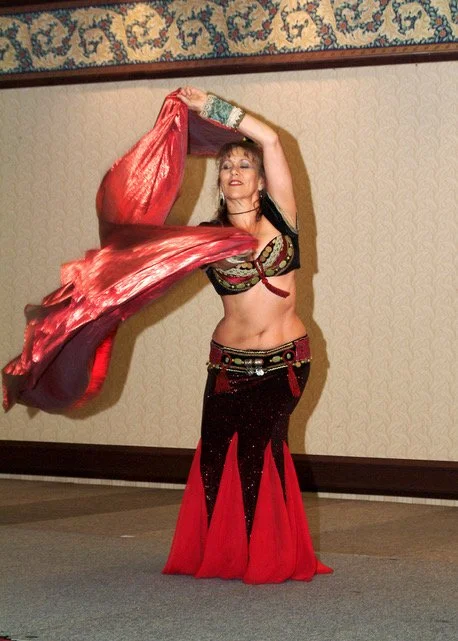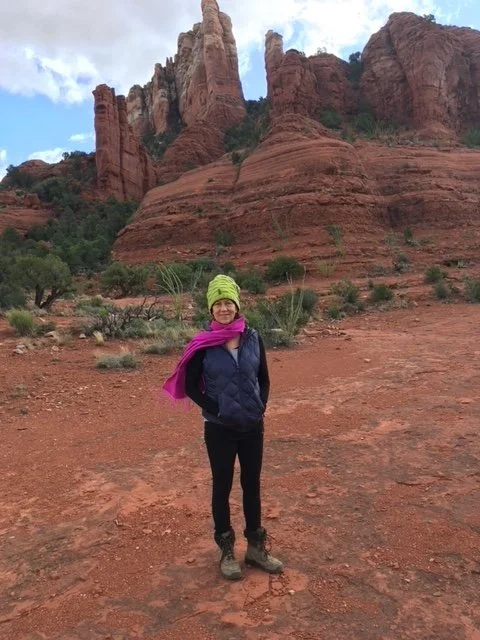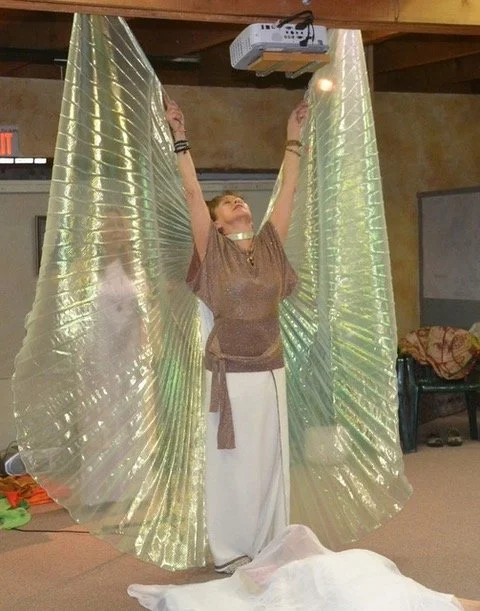Exploring Healing Through Dance: Insights from Cassie Mavis
The Soul’s Divine Dance: An Interview with Cassie Mavis
When we’re in pain, we want it to go away. When we’re blocked, we want to be unblocked. When our minds dwell on something, we want to let it go.
But what if there’s nothing to let go of?
What if it’s all part of the divine dance of our soul’s evolution?
Cassie Mavis, LMT and Reiki Master
For Cassie Mavis, it is always a dance. A massage therapist, Reiki master and dancer, Cassie has been a long-time facilitator of healing. One of her most requested offerings, the Emotional Release Massage, invites clients to explore what lies beneath the pain. For a moment during our interview Cassie’s blue eyes welled with tears of gratitude. “I'm never surprised at the power and simplicity of this work because I see it,” she said.
Her clients see it too. In one session, Cassie addressed her client’s biggest issue: recurring pain in the lower back. Along with her healing touch in this area, Cassie encouraged her client to allow a memory to surface. “At first, nothing came,” said the client. “Then, I remembered a time when I had betrayed a friend. I thought I had healed that, made amends, and moved on. Apparently the pain was still buried in my body because as Cassie worked, it melted away and has not returned!”
My conversation with Cassie felt like a dance. We jumped into the nitty gritty of victimhood, pivoted to forgiveness, and whirled in the realms of ancestral healing. We then sashayed our way into a celebration of this messy and beautiful experience called being human.
Kirstyn: Were you always inclined towards the healing arts? How did it start for you?
Cassie: I had just graduated from college with my BA in physical education from San Diego State when I started working as a physical therapy assistant. They did massage there. I had never done massage before, but I would watch them, and I thought, “I can do that.” I had this one moment with a client where my hand was on a nodule in the back of his neck. It just melted. I could feel it dissolve. He felt it too. That inspired me to go to massage school. That was the beginning.
Kirstyn: You're also a dancer. Were you young when you started dancing?
Cassie: Yeah, I was always a dancer. At some point I realized I was never going to be a Broadway jazz dancer because I started late, but then I saw the sacred art of belly dance. Belly dance can be a way for women to tap into their femininity, their beauty, their power, and their ability to move in ways that incorporate the whole energy system. If you're moving your body, you are moving energy and that's very similar to [healing] work. As you move energy through the body, you're opening up new pathways for that energy to flow.
Kirstyn: What do you bring to your clients in your massage and energy healing sessions?
Cassie: A lot of my work is based on ancestral healing and forgiveness. We address the parts of ourselves that haven't been healed and are ready to be resolved. The healing happens through the breath and the body. They're a great team. They know exactly what to do. The mind always wants to kick in with a story, but the story never gets resolved if you stay in the mind. Inquiring minds always want to know. That's how you stay stuck. If I have a client doing an Emotional Release Massage, I’m always guiding them back to the breath and the body.
Kirstyn: So, it’s the body that intuitively knows how to heal and resolve trauma. It's not going to happen in the mental realm.
Cassie performing bellydance
Cassie: Yes, I would say that's true. I call the body a human treasure chest. Within the realm of the human treasure chest, there are different holding patterns that show up. It could be a physical holding pattern, which can show up as pain or tightness. It could be an emotional holding pattern: ‘I'm not good enough,’ ‘I'm afraid of this,’ ‘Why do I always say yes when I want to say no?’ The mental holding pattern could be how we judge ourselves or compare ourselves to others. Then there's the spiritual holding pattern: a distrust in God. A lot of people have that distrust when there's been so much disappointment. ‘I can't trust men because they always let me down.’ ‘I can't trust women because they always let me down.’ Well, who can you trust? If God wasn't there protecting you and keeping you safe, then you can't trust God either. So there's this wall of separation that can get created between our ability to be in this human form and our ability to trust our gifts, our sense of higher purpose.
When we have these holding patterns and these stories show up, this gets amplified out into the world like an antenna. The universe picks up a signal: ‘Oh, she’s only available for this much love, this much joy, this much abundance.’ We can shift those patterns - and there are different ways to do this - [but in my work] we do it through forgiveness. And people might say, “Oh yeah, I forgave so and so.” But when you really forgive, the memory of a particular incident doesn't have the same charge. There’s no anger, no resentment. When a person is not able to forgive it's because they've been let down for a long time. They want to hold on to feeling justified in blaming another person for their condition in life. But when we take responsibility, which is not an easy thing to do, and when we’re ready, forgiveness happens. If the [body] system isn’t ready, it's okay to hold on to all that stuff. It's serving a purpose. There’s a reason why it’s in our lives and we don’t have to judge it. There's no right or wrong.
Kirstyn: I'm glad you mentioned that when we're not ready, we're not ready because there's this perception that if I feel angry, that's bad. We judge and shame ourselves for feeling anger. But I think it's important to know that if I'm angry, it's just energy that serves as a helper to move me in my next direction.
Cassie: Yeah. It’s like how can we use anger as an ally? It’s showing us something. Anger might be showing me that I am not safe. So what am I going to do to create safety? Some people choose to stay in an abusive situation because that's the only choice they can make. They don't have the bandwidth - an [internal] program - that supports them.
When someone does deep healing work, then they begin to regain the flow of energy. When there's more life force energy flowing, the pattern starts to evolve. Then that person has more bandwidth to say, “I'm done. I'm ready to move on.” Most of us have deep patterns of unworthiness that don’t allow us to make a different choice. I know I have. As I clear and resolve that, I have more energy to make a new choice.
Cassie on the trail in Sedona, AZ
People say, “I have this block and I just want to change it.” My response is “What if there are no blocks?” What if whatever is happening in your life right now is happening because you're ready to face it? It's not a block. It is your body's way of saying, “I'm asking for attention. Please listen to me.” But, it's difficult to be in this now-moment because there's so much anger or bitterness. So we say, “I just want to be over there [where there’s no anger or bitterness].” We say no to ourselves. What if we just said yes to whatever wants to show up?
With ancestral healing and forgiveness work, we go to point in time when a pattern first begins. Maybe it’s a pattern that says ‘it's my fault’ or ‘I'm not enough’. This usually occurs between five and ten years old where imprints can get hooked into the system.
Kirstyn: And when you say ‘hooked into the system,’ do you mean these imprints, or stories, become part of our identity?
Cassie: They become part of how we express ourselves. Usually a memory will surface that a person hasn’t thought about in years. Perhaps it’s a moment when I wasn’t listened to when I was five years old and I just wanted to be held by my dad or mom. I wasn’t acknowledged, seen, or felt. I feel it’s my fault or I didn’t do enough. This can turn into a holding pattern in some area of our life. The pattern arises in adulthood so that we can acknowledge it. When you are able to accept it without judgment, this is when your bandwidth expands, and you become more of who you really are. And I don't do the work. God does the work. You show up. I show up. God shows up at the apex of the triangle. God's really doing the work.
Kirstyn: Let's shift a little bit to ancestors. We also pick up holding patterns generationally. So if there's a history of poverty, or abuse, or genocide even though we didn't experience that ourselves, it’s a patterning in our family lineage. Could you speak about ancestors and how they play a role?
Cassie: Maybe we're in the perfect relationship. We have all the things that show up in the material world. We have the kids, a career, great car, great house, community service and it all looks really nice. But then there's this feeling, let’s say something going on within the mother, where she feels like she's not enough. “What's missing? I have everything. How come I'm so unhappy?” My question might be: What was going on between you and your mom? What was going on between her mother and her mother throughout the generations? The pattern will begin to reveal itself.
Most people want their freedom. We all want to be free. When we clear on an ancestor, we clear for all time, space, realities, and dimensions, for all the ways we were held back, weren't acknowledged, validated, or seen, for all the times we didn't truly feel loved, and for all that contributed to these patterns, for me, my mom, for her mother, and her grandmothers. The lineage was trapped within a certain bandwidth of energetic programming. When it doesn't have an outlet, it doesn't know how to break free. When one person in the lineage starts to acknowledge and validate all the ways their ancestors were held back, disappointed, let down by life or even God, it begins to change. Someone is finally listening. Someone's holding space for them. The result is liberation for the entire family line.
Kirstyn: What would you say to the person who may feel trapped in a victim story? It could be in one’s individual life, or in the victimization that one’s ancestors have endured.
Cassie: That’s a very powerful question because a lot of people do get trapped by being the victim. When people are in that victimhood, that's all they know and there’s no such thing as feeling empowered to make a different choice. There's this feeling of being dominated and manipulated by someone. It could show up in a group of people; African American people, Native American people, Tibetan people went through genocide. What matters is that you can acknowledge where you are. ‘Okay, I feel powerless. I feel helpless.’ That's a powerful point on the journey when you can acknowledge this. Stay a victim for as long as you need to stay a victim, and then eventually it changes if you continue to observe.
Staying a victim plays a very crucial role until it doesn’t. When you recognize that, you uncover another layer. Layers are peeled back, insights come, and the ability to make different choices happens. Life starts to have a different trajectory. Even a one percent shift is powerful. Hours before the crash, if the Titanic had made a one percent change in its trajectory, it would have missed the iceberg, right? So, a one percent shift in however we can show up for ourselves by accepting where we are, not judging, not trying to make it go away, allows for a little bit of a choice. That choice turns into a bigger choice, and then a bigger one, and eventually life becomes different.
Cassie Mavis performing in Sedona, AZ
When we change these patterns within ourselves, we also change them collectively. An energetic shift in one person gets expanded out into the universe as information that is now available in the field. Can you tap into this field? You might say, “No, I’m still a victim and I can’t imagine it.” That’s okay. Eventually that field is going to get bigger and the person who can’t even imagine it will start to say, “Yes, I can imagine how my life could be different. My life is changing. I’m making new choices.” That's the power of all of us doing this work.
Kirstyn: Have you noticed a shift in consciousness of people that you’ve been working with over the years?
Cassie: Things are at a point where people realize that they can't do it the old way anymore. Even in the uncomfortableness of it all, there's a recognition that I need to do the inner work to make a different choice for myself. But, people don't know where they want to go. We’re in this holding pattern where things are not easy. It's not comfortable and most of us don't like to be uncomfortable. So, we have this tug of war going on within ourselves. What if we could just accept it all? All the angst, all the uncertainty, all the ways that we were affected by whatever choices we made or our ancestors made in the past. What if it's all perfect? Because again it just means that you're ready to resolve it. You're ready to forgive, so that you can be more of who you truly came to be.
Kirstyn: Yes, I love that perspective. There’s this next version of me that I've been too afraid to step into - a more authentic version. I’m recognizing all the ways I’ve been faking it. All the stories are in my face and I can’t escape. I realize I'm so much more than all these stories. But I can’t quite go there yet. I'm trying, but I keep hitting my head against a wall.
Cassie: Yes, and all that serves a purpose. ‘I have this block.’ Who cares? ‘I have this resistance.’ Who cares? It's the judging of it that amplifies it even more. ‘I should be this.’ No. We're just in the soup right now. We're in the cauldron. There's resistance. There's fear. And there is awareness itself. Giving voice to the awareness allows for change. And it will change because you can't do life wrong. When you know something in the fiber of your being, it is already set in motion. You are coded to do what you came to do. It will happen. In this fast paced culture everything is drive-up: drive-up coffee, drive-up banking, drive-up fast food. We're so used to having things now and that's part of the program. We want it to be different now. ‘Why do I have to go through all this?’ When I give myself permission to be in the yuckiness of it all, accepting all that it's bringing up, it shifts. When we have enough awareness, we can look back and see the value of why the yuck was in our lives. The ultimate gift is to be in all the messiness of what it is to be human. We're here to evolve. There's no race to the finish line.
Kirstyn: What brings you joy?
Cassie: Performing. Dance is coming through in a different way because I'm older. and I have a few more wrinkles now [laughs]. But, I can feel in my body a richness — an alignment with Source and an alignment of my physical, emotional, mental, and spiritual bodies — that I didn’t have when I was younger. When we do what we love, energy starts flowing and there's more expression.
Kirstyn: What's your favorite spot in Sedona?
Cassie: There’s one area of the creek where I feel so nurtured. That's the most magical place in Sedona for me. It took me 10 years to find it, but I always had a knowingness that it existed. I can be there, alone, and be held by the Mother in the purest sense. I’m baptized by those waters. It’s an amazing gift. I hold it sacred to my heart.
Kirstyn: I feel that the sacred energy of those waters is also what you give to other people. Even in this interview, you were hitting on things I needed to hear today. So, thank you.
Cassie: Thank you. Bless you, Kirstyn. I’m cheering you on.
Cassie offers a variety of services at Gateway Cottage Wellness Center. To schedule a session with her, call us at 928-862-4400.
Story by: Kirstyn Lazur
Kirstyn Lazur is the author of I Was Cursed in Connecticut, a memoir that recounts her unique and supernatural journey after the death of her mother. Her book is available through Amazon and Gateway Cottage Wellness Center’s online store.




